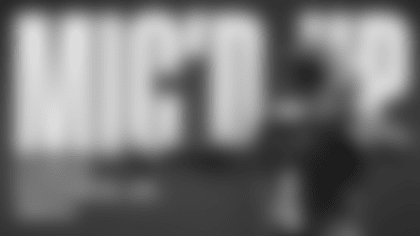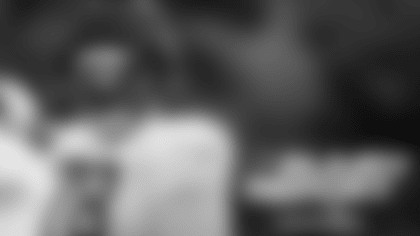The NFL's 2020 calendar year begins on Wednesday, March 18, with the free agent market opening at 4 p.m. ET. That's an important date for the Tampa Bay Buccaneers, who can't help but be players in free agency, if only due to their own expiring contracts and an interesting salary cap situation. The Buccaneers currently have 19 players who could become unrestricted free agents on that mid-March Wednesday, and they have more than $90 million of estimated cap space, pending any re-signings in the interim.
Eight weeks remain before that 2020 kickoff, which is the amount of time the Buccaneers and their 31 fellow NFL teams have to devise a strategy for free agency and potentially reduce their own list of free agents before the market opens. As free agency approaches we're taking a position-by-position look at what the Bucs have, who they could lose and who they could look at from other teams on the open market. Our 2020 Free Agency Primers continue this week with the running back position.
January 15: Offensive Line
January 22: Safety
January 29: Running Back
February 5: Cornerback
February 12: Tight End
February 19: Linebacker
February 26: Wide Receiver
March 4: Defensive Line
March 11: Quarterback
March 18: Outside Linebacker
2019 Output: For the fourth year in a row and the sixth time in the last seven years, Tampa Bay's rushing attack finished in the bottom third of the NFL's yardage ranking. Specifically, the Bucs were 24th in that category in 2019, averaging 95.1 yards per game. They were also 28th in yards per carry, at 3.72; the average across the league was 4.32. Tampa Bay did manage to score 15 touchdowns on the ground, which was the team's best mark in that category since 2007. The Bucs' rushing attack also finished on an upward swing, topping 100 yards and 5.0 yards per carry in each of its last two games.
Individually, Peyton Barber and Ronald Jones II split the 16 backfield starts nearly down the middle, with Barber opening the season as the incumbent but Jones assuming the job for the last nine games. Their final carry totals were close, too, with Jones taking 172 handoffs to 154 for Barber. The 2018 second-year back was more productive with his carries, gaining 724 yards and averaging 4.2 yards per carry to 470 and 3.1 for Barber. They each scored six times. Jones also had 31 catches to 16 for Barber.
Overall, Jones had a far more productive second season after a nearly lost rookie campaign. Bruce Arians, Byron Leftwich and the Bucs' new staff was able to get over 1,000 yards from scrimmage from the former USC star after he was held to 77 yards as a rookie and got only 23 carries. Dare Ogunbowale filled the third running back role for the entire season and was frequently on the field on third downs. That led to 35 catches for 286 yards, but his 11 carries generated just 17 yards, along with two touchdowns. Ogunbowale also played extensively on special teams and took over as the kickoff returner after a late-season injury to T.J. Logan. Logan worked almost exclusively as a return man, logging just three carries for 10 yards and two catches for 13 yards.
While the Bucs had an explosive passing attack in 2019, the run game didn't generate a lot of big plays. Tampa Bay ranked 25th in the league with 9.5% of its carries going for 10 or more yards. During the first half of the season, Jones had several long runs called back by penalties; that, too, improved down the stretch as he broke off jaunts of 49, 33, 25 and 16 yards in the last two games.
Under Contract for 2020: The Buccaneers have their starter in the backfield returning for 2020 after Jones took over that job from Barber in October. After the significant strides made by Jones in his second season, and his reasonably strong average per carry, it seems likely he'll go into next season with that job, too.
Ogunbowale should be back to compete for a third-down job again, as well, and to continue contributing in many ways on special teams. Ogunbowale is a heady player who clearly has the trust of the coaching staff in terms of pass protection. He got a brief cameo on the active roster in 2018 after spending most of the year on the practice squad and the Bucs saw enough to sign him to a reserve/future contract at the end of that season. That was a two-year deal, so Ogunbowale is still under contract in 2020.
Logan's deal also runs through 2020 because the Buccaneers acquired him via waivers during the league's big round of roster cuts in September and thus inherited his rookie contract from December. In addressing the need for a more dynamic return game in 2020, Arians expressed confidence that Logan could provide that after returning from his broken thumb. The Bucs also have first-year back Aca'Cedric Ware, another USC product, on the roster after signing him to a reserve/future contract in early January. Ware spent the last 10 weeks on the Bucs' practice squad and thus will head into the offseason with a good feel for the offense.
Buccaneers' Pending Free Agents: There is just one running back on the Bucs' long list of potential free agents in 2020: Peyton Barber. Barber started 26 straight games for the Buccaneers before ceding the job to Jones in 2019 but his yards-per-carry figure shrank from 3.7 in 2018 to 3.1 last year.
Barber has spent his first four NFL seasons in Tampa after originally arriving as an undrafted free agent out of Auburn in 2016. He was very briefly on the practice squad at the beginning of his rookie year but was promoted before the first game and has since played in all but one contest over those four years. Barber signed a one-year deal last March prior to becoming a restricted free agent; now, with four accrued seasons, he is due to become an unrestricted free agent on March 18.
Potentially Available Free Agents: The top of this list would have looked a lot different at midseason. Then Tennessee's Derrick Henry turned in one of the greatest stretch runs (including playoffs) in league history and Miami's Kenyan Drake found a new home and a new gear after being traded to Arizona. Since Henry's incredible power running and big-play explosiveness were instrumental in getting Tennessee to the AFC title game, the common belief is that he'll reach a new deal with the Titans. Drake, however, may want to see what the market holds for him after he racked up 841 yards from scrimmage and eight touchdowns in eight games as a Cardinal. Drake was already regarded as a good pass-catching back before the trade but he averaged 5.2 yards per carry in Arizona.
Also headed towards free agency are two running backs who recently had big seasons as feature backs and are still in their prime but need to re-establish themselves. One is the 24-year-old Kareem Hunt, who led the NFL in rushing as a rookie in 2017 but got released by Kansas City due to off-the-field trouble and was an afterthought in Cleveland last season. Hunt also recently ran into some more trouble, as well. The other is 26-year-old Melvin Gordon, who scored 28 touchdowns and ran for nearly 3,000 yards from 2016-18. Gordon missed four games last season on a holdout that failed to produce a new deal with the Chargers and saw his per-carry average drop from 5.1 in 2018 to 3.8. However, he did reach the eight-TD mark for the fourth straight year. He's a powerful back and he catches the ball well.
Some RB-shopping teams might prefer the player who benefitted the most from Gordon's holdout: Austin Ekeler. The former undrafted free agent exploded for 1,550 yards from scrimmage and 11 touchdowns and was simply one of the best pass-catching backs in the NFL. His 92 receptions for 993 yards and eight touchdown, not to mention his average of 9.2 yards per target, would be attractive to teams looking to complement a Gordon-type back with a dynamic and versatile weapon out of the backfield. Teams in that market might also consider Washington's Chris Thompson and the Jets' Bilal Powell, two backs who have had good pass-catching numbers in their careers.
If the Bucs do some shopping on the RB market, they might try to entice a local product to come back home. That would be Matt Breida, part of the 49ers ultra-productive rushing attack. Breida, another former undrafted free agent, played his high school ball in Spring Hill north of Tampa. Breida dealt with some injuries last year and Raheem Mostert has recently taken the lead role for the 49ers, but he had a productive first half and has produced whenever given the chance in San Francisco, as his career average of 5.0 yards per carry attests.
Philadelphia's Jordan Howard used to be the lead back in Chicago and could conceivably regain that status with a new team. He's still just 25. Lamar Miller could be looking to do the same after his last year in Houston was lost to an ACL tear, but he's 29 which is an advanced age for most NFL running backs. The Raiders' DeAndre Washington and the Colts' Jonathan Williams are two reserves who filled in well for their teams' injured starters at times in 2019 and might be deserving of a larger role. Some teams may also try to see how much a quartet of older veterans have left in the tank: LeSean McCoy, Carlos Hyde, Marshawn Lynch and Frank Gore.
Bucs' Interest Level: Moderate.
If the Buccaneers do not re-sign Barber – or maybe even if they do – they would almost certainly need to make some additions to the backfield depth chart. As much promise as Jones has shown he's probably still going to be sharing carries with at least one other back, and the Bucs may try to add a few options in the offseason to set up a competition in training camp. If we go back to the top of this page and review the numbers from recent years, too, it seems clear that the Buccaneers need some more explosive play-making in their running back corps.
Of course, this is the position, perhaps above all others, that most teams prefer to address in the draft. Rookie running backs can often step right into productive roles and be cost-effective options for four a number of seasons. Given the relatively short careers that backs have on average – a curve that Frank Gore is doing all he can to wreck – some might hesitate to give large deals to backs on the back half of their 20s. The five running backs with the largest cap hits for 2020 who are with their current teams after signing as an unrestricted free agent are Le'Veon Bell, Jerick McKinnon, Mark Ingram, Dion Lewis and Tevin Coleman. Only the Ingram signing would probably be called an unqualified success at this point.
If the Buccaneers do choose to dip into the free agent running back market, perhaps they will hunt for a short-term value signing, such as the type of one-year deals they gave out last year to Shaq Barrett, Ndamukong Suh, Breshad Perriman and Earl Watford. When Bruce Arians first arrived in Arizona as the head coach in 2013, his team signed former Steeler Rashard Mendenhall to a one-year deal and then selected both Stepfan Taylor and Andre Ellington on the third day of that year's draft. Both Mendenhall and Ellington topped 650 rushing yards that year and they combined for 11 touchdowns and 57 catches. However, the Cardinals' most important and impactful move at running back in Arians' tenure was the third-round selection of David Johnson in 2015.
The Buccaneers have some work to do at the running back position, and to pump more life into their ground game overall. That could involve some work on the free agent market but, as we noted last week when discussing the safety position, the team is likely to prioritize such positions as defensive line, outside linebacker and quarterback, with a long list of their own free agents needing attention.





































